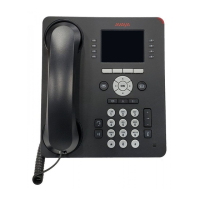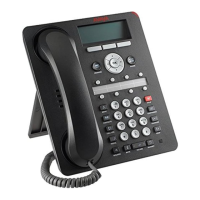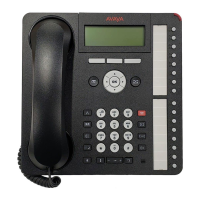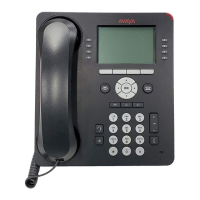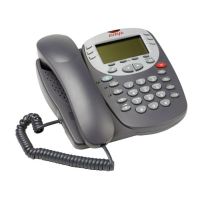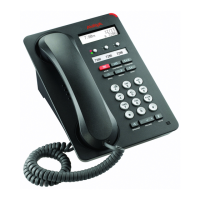Do you have a question about the Avaya 1120E IP and is the answer not in the manual?
Lists key features of the IP Deskphone, including programmable keys and display.
Explains user-defined keys, context-sensitive soft keys, volume, and mute functions.
Details Handsfree, Navigation Cluster, Enter, and Goodbye/Release keys.
Describes Headset, Hold, Dialpad, Alerter, and Copy keys.
Details Inbox, Outbox, and Directory keys for call logs and contacts.
Provides cleaning instructions and introduces context-sensitive soft keys.
Details the 'Feature' soft key and its associated menu items.
Explains Redial, Msgs, and the abc/123 soft keys for input.
Covers 'Prefs' soft key for display, audio, and feature options.
Describes scrolling and text editing functions of the Navigation Key Cluster.
Details backspace, highlighting, and USB mouse usage.
Lists call features and introduces security requirements like ID/password.
Explains how to identify a secure connection using the padlock icon.
Lists EMC and safety compliance standards for various jurisdictions.
Covers additional regulatory info for US/Canada, EU, Australia, and Japan.
Overviews essential sections for using the IP Deskphone, including setup.
Highlights cautions for connecting components and general warnings.
Illustrates and lists the various ports and connection points on the phone.
Details removing stand cover and preparing for wall mounting.
Provides instructions for connecting the optional AC power adapter.
Guides on connecting the handset cable and cord routing.
Explains headset connection and automatic tuning parameter application.
Details connecting the IP Deskphone to the LAN via Ethernet cable.
Guides on connecting USB devices and wall-mounting the phone.
Detailed steps for wall-mounting using method A (screws).
Steps for method B and introduction to text entry.
Explains using the dialpad for text and switching input modes.
Lists special characters and key presses for dialpad key 1.
Continues character list and notes on the 0 key.
Guides on setting dialpad default to alphabetic or numeric.
Explains using a USB keyboard for text entry and feature access.
Maps USB keyboard function keys to IP Deskphone fixed keys.
Outlines steps for logging on, including ID, password, and duration.
Explains auto login setup and configuring the domain for login.
Details password protection for editing domains and switching.
Explains how to select the interface language for the IP Deskphone.
Details entering user ID and selecting input modes for logon.
Finalizes logon with password confirmation and options to cancel.
Explains setting login duration and timed logoff.
Details selecting and saving a location in the User Profile.
Guides on adjusting the display contrast level.
Explains creating custom text messages for the idle screen.
Details setting backlight duration and screensaver configuration.
Explains setting the time interval for menu auto back-out.
Provides steps to adjust the ring volume for incoming calls.
Explains how to adjust the handset volume.
Guides on adjusting headset volume.
Details adjusting handsfree mode volume.
Explains how to select and change the display language.
Guides on selecting date and time formats.
Details how to select and configure the time zone.
Explains how to select the time format (12/24 hour).
Lists various USB headset types compatible with the phone.
Shows headset options and configuration screen.
Details active device and wired headset type settings.
Covers HID commands, MHS type, and MHA back light.
Explains checking USB headset presence using the System menu.
Describes selecting audio formats and generic headset behavior.
Details HID support for Avaya USB adapters and features.
Describes LEDs, indicators, call handling, and key mappings.
Details key events and LED control for third-party headsets.
Covers indicators, call handling for third-party headsets.
Lists ATA characteristics for key events, indicators, and call handling.
Guides on making calls by lifting handset or using headset/handsfree first.
Details using Redial, Msgs, and Send soft keys for off-hook dialing.
Explains dialing before off-hook and switching to handsfree.
Guides on using headset and redialing for calls.
Provides steps to make an intercom call.
Details entering numbers for paging calls and confirming.
Explains how to retrieve voice mail messages.
Explains how incoming caller ID information is displayed.
Provides methods to answer, ignore calls, and configure Call Ignore.
Guides on enabling and disabling the Do Not Disturb feature.
Describes how intercom calls are handled, including auto-answer.
Explains how members can answer other members' calls.
Describes paging call behavior, including one-way audio.
Guides on setting up and disabling call forwarding.
Explains how to access and view contacts in the Address Book.
Guides on making calls directly from contacts in the Address Book.
Provides steps to add new contacts with name and number/SIP.
Explains how to edit existing contact information.
Details editing name, SIP address, or phone number for contacts.
Covers designating contacts as friends and completing edits.
Guides on how to delete contacts from the Address Book.
Explains copying contact info from Call Inbox/Outbox to Address Book.
Explains changing the default search method (Index, 1st Char, Name).
Guides on performing local searches using various criteria.
Details entering search criteria and handling search results.
Explains results when a search yields no entries.
Explains accessing and managing calls when idle or active.
Details navigating, filtering missed/all calls, and deleting.
Covers using Enter key, dial pad, and call actions from inbox.
Explains how to view detailed information for calls in the inbox.
Provides steps to view and manage missed calls.
Explains changing notification behavior and setting clearing modes.
Guides on deleting individual or all calls from the Call Inbox.
Explains how to access the Call Inbox while on an active call.
Explains accessing and managing calls when idle or active.
Provides steps to initiate a call from the Call Outbox.
Explains deleting and viewing call details in the Outbox.
Guides on deleting calls from the Call Outbox.
Explains how to initiate a new call while on an active call.
Describes handling incoming calls and placing calls on hold.
Explains how to manage multiple calls on hold using navigation and soft keys.
Describes 'NewCall' and 'Audio' soft keys for managing multiple calls.
Details navigating 'More...' menu and using 'Trnsfer' soft key.
Covers 'Prefs' menu options like Display, Audio, Feature Options.
Details Network and USB Locks options via 'Prefs' menu.
Guides on accessing held calls and placing active calls on hold.
Explains establishing a conference call between active and held calls.
Introduces the process of transferring a call.
Guides on entering transfer destination and consultation option.
Explains temporarily parking a call for retrieval.
Guides on retrieving a parked call using the retrieval code.
Introduces programmable keys for activating features.
Guides on programming keys to activate features like Call Forward.
Explains programming keys for speed dialing.
Guides on checking functions assigned to programmable keys.
Details restricting caller information for incoming calls.
Explains restricting outgoing call information.
Allows specifying and modifying codecs for active calls.
Explains selecting codecs and modifying preferred order.
Details enabling/disabling screensavers and setting delay, image, text.
Explains screensaver modes and interaction.
Explains how to display uploaded screensaver images in slideshow.
Guides on selecting and configuring background images.
Details file manager navigation and browsing screens.
Explains options in file manager root and device selection screens.
Details file sending and deletion options within the file manager.
Explains OK and Back options for file transfer destination.
Details copying an image file from USB to IP Deskphone.
Explains copying ring tones from IP Deskphone to USB.
Describes error messages related to file copying.
Guides on accessing basic phone information like load version.
Explains viewing USB port and E911 information.
Lists the main options available in the Services menu.
Introduces erasing user data like profiles, sounds, languages, system files.
Guides on accessing File Manager to delete user data.
Details selecting files/folders for deletion in the File Manager.
Guides on deleting user profiles, sound, language, and log files.
Lists options in the Network menu like Server Settings and Diagnostics.
Explains the process for automatic software updates.
Illustrates icons for call states and features.
Explains the function of the red LED for incoming calls and voice mail.
Details LED status for voice mail and incoming calls.
Introduces fixed keys and describes short-cut/navigation keys.
Details telephone feature keys like Volume, Mute, Handsfree.
Describes Goodbye, Headset, and Hold keys.
Provides procedures for commonly used functions like Login/Logout.
Lists soft key menus for idle and active call displays.
Describes soft keys for idle display like Redial, Msgs, Prefs.
Details soft keys for active calls like Conf, Trans, Audio.
Covers Prefs menu and 'More...' navigation during active calls.
Lists unsupported features like Decline softkey and Call Subject.
Introduces third-party terms for Avaya software.
Covers the Public Domain notice for the DateTime component.
Provides GNU GPL text for libstdc++.
Details terms for copying, distributing, and modifying under GNU GPL.
Outlines requirements for distributing modified programs under GNU GPL.
Covers distribution restrictions and warranty disclaimers.
Discusses compliance, country restrictions, and license versions.
Covers Zlib, Libpng, and Kern_random licenses.
Outlines conditions for using libjpeg software.
Covers the T-Rex license and its restrictions.
Discusses acknowledgment and source distribution for T-Rex.
Defines terms like Alphanumeric Dialing, Call Decline, Call Forward, Call Server, Call Subject.
Defines terms like Cat6, Conference Call, soft keys, DN, Domain, Do Not Disturb.
Defines keys like Enter, Expansion Module, Fixed keys, Goodbye, Handsfree, Hold, and indicators.
Defines terms like Message/Inbox, Mute, Navigation, Off-Hook, SIP.
| Headset Support | Yes |
|---|---|
| Speakerphone | Yes |
| Connectivity | 10/100 Mbps Ethernet |
| Power over Ethernet (PoE) | IEEE 802.3af Class 2 |
| Audio | G.711, G.729a |
| Protocols | SIP, H.323 |
| Buttons | Programmable buttons |
| Ethernet Ports | 10/100 Mbps |
| Power Source | PoE or power adapter |

